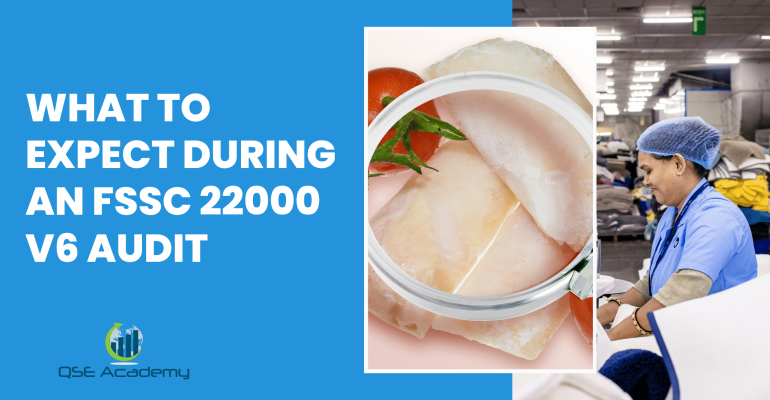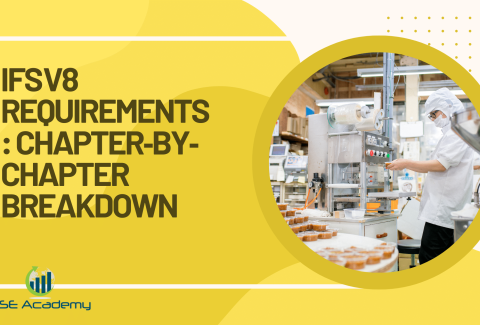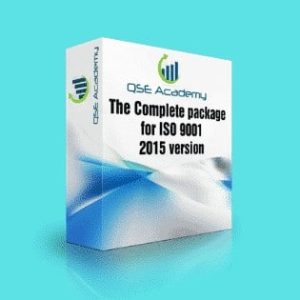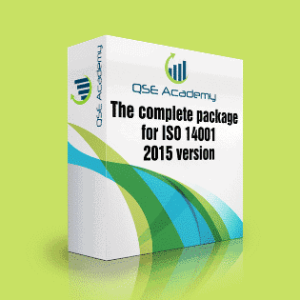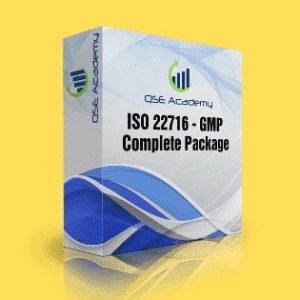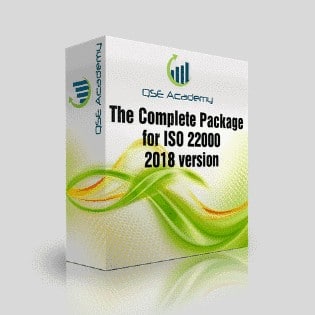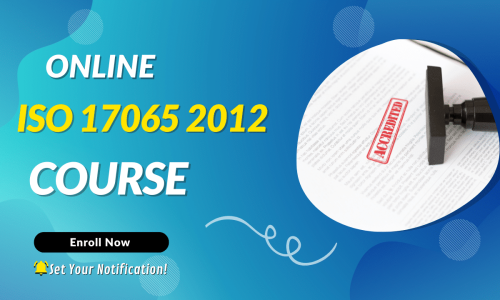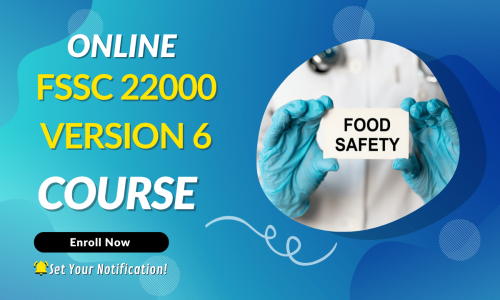What to Expect During an FSSC 22000 V6 Audit
Last Updated on October 13, 2025 by Hafsa J.
What to Expect During an FSSC 22000 V6 Audit
Let’s be real—when most teams hear “FSSC 22000 audit,” stress levels go up. And now that we’re dealing with Version 6, the pressure’s even higher. I’ve seen it firsthand—teams scrambling days before the audit, unsure if they’re truly ready, and hoping the auditor won’t dig too deep. Spoiler alert: they will.
In my 12+ years as a food safety consultant, I’ve helped bakeries, dairy plants, and massive export operations not just pass their audits, but walk away feeling proud of how far they’ve come. And if there’s one thing I’ve learned? The audit process doesn’t have to feel like a mystery.
This article is here to take the guesswork out of the FSSC 22000 Version 6 audit. I’ll walk you through exactly what to expect—before, during, and after the audit. We’ll cover the key updates in V6, what auditors are really looking for, and how to avoid common missteps that can cost you your certificate.
Whether this is your first time or you’re preparing for recertification, I’ve got you covered—with real insights, clear steps, and zero fluff.
Ready? Let’s dive in.
Understanding the FSSC 22000 V6 Audit Framework
Let’s start with the basics—because if you don’t understand the structure of the audit, it’s hard to feel fully prepared.
If this is your first time going through an FSSC 22000 audit, here’s what you can expect: it typically happens in two main phases.
Stage 1: Documentation Review
This part is all about showing that your food safety management system (FSMS) exists on paper. The auditor wants to confirm that you’ve addressed the standard’s requirements and that you’re ready for a deeper look. Think of it as a dress rehearsal.
Stage 2: On-Site Audit
Here’s where the real test happens. The auditor visits your facility, walks the floor, interviews staff, observes operations, and checks that what’s in your documents is actually being practiced on the ground.
After that, certified companies are subject to annual surveillance audits and a full recertification every three years.
Now, here’s where it gets interesting. Version 6 of FSSC 22000 brings in some important updates—ones you definitely want to be ready for.
Key Changes in FSSC 22000 Version 6
In my experience, the biggest challenges come not from the routine checks, but from the new expectations auditors are trained to focus on. Version 6 sharpened its focus in a few key areas:
-
Food Safety Culture: This is no longer a buzzword—it’s a measurable part of your audit. Auditors want to see leadership engagement, employee awareness, and actual behavioral evidence that food safety matters at every level.
-
Audit Duration Adjustments: Audit time may increase depending on your complexity, site size, or scope. I’ve had clients surprised by an extra day being added—don’t let that catch you off guard.
-
QR Codes on Certificates: FSSC certificates now include a QR code to help stakeholders verify authenticity instantly. It’s a small detail but signals the scheme’s push for transparency.
-
More Stringent Unannounced Audit Options: Unannounced audits are no longer rare. Your organization must be ready for a visit at any time during the audit cycle—this means systems need to be audit-ready every day, not just during “crunch time.”
These changes are designed to push companies beyond just having compliant documentation. Now, it’s about embedding food safety into the company culture in a real, lasting way.
In short? Auditors aren’t just looking for systems anymore. They’re looking for proof of ownership—and that starts with your people.
Pre-Audit Activities and Documentation Review
Now that we’ve got the framework down, let’s talk about what happens before the auditor even steps foot in your facility. This is where a lot of companies either shine—or stumble.
What Happens During Stage 1
The Stage 1 audit is usually a remote or onsite review of your documentation. It’s not about catching you off guard—it’s to make sure your management system is ready for a full audit. Think of it as the “is your paperwork in order?” checkpoint.
Here’s what the auditor typically checks:
-
Your documented Food Safety Management System (FSMS)
-
Your Prerequisite Programs (PRPs) based on ISO/TS 22002-1 or applicable sector-specific rules
-
Your hazard analysis and critical control points (HACCP) or equivalent
-
Internal audits and management review records
-
Your facility’s scope of certification
-
Any actions taken for legal and regulatory compliance
I always advise my clients to approach Stage 1 as a full-dress rehearsal. If your documents are outdated, incomplete, or confusing—even if your actual practices are strong—it sets a bad tone for Stage 2.
What You Should Prepare Ahead of Time
Here’s a quick checklist I use with my clients before a Stage 1 audit:
-
A clear FSMS manual that links to procedures and records
-
A well-defined process map showing how products move from raw material to distribution
-
A list of applicable food safety laws and regulations
-
Evidence of corrective and preventive actions
-
Records of food safety culture activities (yes, this matters now!)
In my experience, having a well-organized document system—preferably digital, but even a well-maintained binder system works—makes a huge difference. Auditors don’t want to dig. They want clarity.
One More Thing: Know Your Why
I’ve walked into companies where employees could quote policies word-for-word… but couldn’t tell me why they mattered. That’s a red flag.
During the Stage 1 review, auditors often ask about management commitment, training records, and risk-based thinking. Be prepared to show not just the documents—but the intent behind them.
Because when your documents tell a story—and your team can back it up—you’re already halfway there.
Onsite Audit: What the Auditor Looks For
Here’s where the pressure really kicks in. Your team has prepped the documents, cleaned the facility, and briefed the staff. Then the auditor walks in—and now it’s game time.
But let me be clear: this isn’t just about ticking boxes. The FSSC 22000 Version 6 onsite audit is about proving that your system is alive and working—not just existing on paper.
What to Expect on Audit Day
An onsite audit usually spans one to three days, depending on your company’s size and scope. Here’s a snapshot of what the auditor will do:
-
Tour the facility—from receiving to dispatch
-
Observe operational practices in real-time (not just review SOPs)
-
Interview employees at all levels—from top management to frontline operators
-
Review records, logs, and monitoring reports
-
Check how nonconformities are addressed and corrected
-
Examine traceability, allergen control, cleaning schedules, pest control, and more
In my experience, the most successful audits are the ones where everyone on the team—not just the managers—understand their role in food safety.
Auditors Are Looking for Reality, Not Just Policy
Let’s say your cleaning schedule is perfectly documented. That’s great. But if the auditor walks into a production area and spots grime in a hard-to-reach spot, that’s what they’ll focus on.
Here’s what auditors are really watching for:
-
Consistency between your documentation and real-world practices
-
Employee awareness—Can your staff explain how they contribute to food safety?
-
Corrective actions that show you don’t just fix problems, you prevent them from recurring
-
Monitoring and verification activities that demonstrate control
One of my clients—a frozen food manufacturer—nailed their audit because even the forklift driver could explain how his role helped prevent cross-contamination. That’s what food safety culture looks like in action.
What’s Changed Under Version 6?
You’ll notice that under Version 6, auditors are far more focused on:
-
Food safety culture in practice—Are values embedded, or just posters on the wall?
-
Leadership engagement—Does top management actively support the FSMS?
-
Risk-based thinking—Do you identify, assess, and proactively manage risks?
It’s not enough to have procedures. You need to show that they’re working—and that people believe in them.
Quick Tip from the Field
Here’s something I always recommend:
Train your staff to explain their tasks in their own words—not auditor-speak. When they can confidently say why they do something and how it prevents food safety issues, that carries far more weight than a memorized policy.
Common Nonconformities in FSSC 22000 Version 6 Audits
Here’s the truth no one wants to admit: even well-prepared companies get hit with nonconformities. And that’s okay—as long as you know how to handle them. The real problem isn’t the finding itself—it’s being blindsided by something you could’ve seen coming.
In my experience, the same issues tend to pop up again and again. Let’s walk through the big ones so you can get ahead of them.
1. Weak or Superficial Food Safety Culture
This is a biggie in Version 6. Auditors aren’t just checking for a written policy on food safety culture—they want proof that it’s actually practiced.
Here’s what raises red flags:
-
Staff unaware of basic food safety responsibilities
-
No documentation of culture-building efforts (like training, surveys, or leadership reviews)
-
Zero evidence that management is engaged or actively supporting the FSMS
If your culture only shows up during audit week, you’re in trouble.
2. Incomplete or Inaccurate Hazard Analysis
I’ve seen companies breeze through the tour, only to stumble hard when the auditor starts picking apart their hazard assessment. A few common issues:
-
Overlooking minor ingredients that still pose risk
-
Weak justification for CCP selection (or lack of CCPs altogether)
-
Not accounting for potential cross-contamination paths
A sloppy HACCP plan is like a shaky foundation—everything above it wobbles.
3. Vague or Inadequate Recall and Withdrawal Procedures
Your recall plan should be crystal clear. I once worked with a company that had a 20-page document—but no one on the floor could explain how to use it. That’s a problem.
What auditors expect:
-
Roles and responsibilities clearly defined
-
Mock recalls conducted and documented
-
Clear timelines and traceability for affected products
If it’s too complex to follow under pressure, it’s not going to work.
4. Environmental Monitoring Gaps
Especially in high-risk environments, this is becoming a more common finding. Auditors are asking:
-
Do you monitor frequently enough?
-
Are you sampling the right zones (and enough of them)?
-
What do you do with unsatisfactory results?
A strong plan backed by trend data can help you avoid a major nonconformity here.
5. Untrained or Unaware Staff
This one is so preventable—and yet I see it way too often. Staff don’t need to be experts, but they should:
-
Know their tasks and how they impact food safety
-
Understand hygiene and allergen protocols
-
Be able to answer simple audit questions confidently
If someone shrugs and says “I’m not sure why we do that,” that’s a red flag for the auditor—and for your management system.
The Bottom Line
Most nonconformities aren’t about big disasters. They’re about disconnects between your system and your people. Close that gap, and you’ll drastically reduce your risk.
Post-Audit: Nonconformity Closure and Follow-Up
So, the auditor just wrapped up. Maybe you’re breathing a sigh of relief—or maybe you’re staring at a list of nonconformities and wondering what it all means.
Here’s the good news: this phase is all about action and improvement. And if you handle it right, it can strengthen your system—not just patch holes.
Understanding Your Audit Report
Right after the audit, you’ll receive a summary of findings, followed by the full audit report. This includes:
-
A list of nonconformities (major, minor, and observations)
-
The auditor’s overall impression of your FSMS
-
Deadlines for corrective actions
-
The certification body’s next steps
Important note: a nonconformity isn’t a failure—it’s an opportunity. What matters most is how you respond.
Timelines for Corrective Actions
Let’s break this down:
-
Major nonconformities must be closed (with evidence submitted) within 30 days—or certification is delayed.
-
Minor nonconformities typically require action before the next audit but don’t block certification unless they pile up.
-
You’ll need to submit a Corrective Action Plan (CAP) for each finding.
Here’s what the CAP should include:
-
A clear root cause analysis—not just a guess
-
The corrective action you’re taking
-
The timeline for implementation
-
Evidence of follow-up and verification
I always tell clients: don’t just fix the symptom. Fix the system that let it happen in the first place.
How Certification Decisions Are Made
Once your CAPs are reviewed and accepted, the certification body makes the final call. If everything checks out:
-
You’ll receive your FSSC 22000 V6 certificate
-
Your certification will be valid for three years, with surveillance audits each year
If there are unresolved issues—or your CAPs aren’t convincing—you might need a follow-up audit, or worse, face suspension.
Beyond the Certificate: Continuous Improvement
The best companies don’t treat the audit as a finish line. They use it as a launchpad for improvement.
What that looks like in practice:
-
Regular internal audits that go deeper than the surface
-
Scheduled management reviews focused on culture and performance
-
Ongoing employee training tied to real observations, not just PowerPoints
-
Data tracking to spot trends early—before an auditor does
I’ve seen companies turn a rough audit into a moment of growth—by owning the findings, acting fast, and making real changes. That’s what a mature food safety system looks like.
How Long Does an FSSC 22000 Audit Take?
One of the first questions I get from clients is: “How many days should we block off for the audit?” And my answer is always: “It depends—but I can give you a pretty solid estimate.”
The time it takes to complete an FSSC 22000 audit isn’t one-size-fits-all. It varies based on your facility, your processes, and how complex your food safety system is. But there are general patterns you can plan around.
Factors That Affect Audit Duration
Here’s what determines how long your audit will take:
-
Facility size and number of employees
A single-site bakery with 30 employees won’t take as long to audit as a multi-site dairy operation with 300 staff across three shifts. -
Product categories and risk level
High-risk categories—like ready-to-eat meals or infant food—typically require more scrutiny. -
Number of processes and lines
The more process steps, products, and controls you have, the more time auditors need to verify everything. -
Previous audit history
If this is your first audit, expect a bit more time. If you’re being recertified and have a clean track record, the duration may be streamlined.
General Time Guidelines
To give you a ballpark, here’s what I usually see:
-
Initial certification audit (Stage 1 + Stage 2)
-
Stage 1: 1 to 2 days (remote or onsite)
-
Stage 2: 2 to 4 days onsite
-
-
Surveillance audits
-
Typically 1 to 3 days, depending on scope and any changes since the last audit
-
-
Recertification audit
-
Similar to the initial Stage 2 audit (2 to 4 days), but more focused on system maturity and improvement
-
These timelines are per site. If you’re running multiple locations under the same certification, each will be sampled based on the FSSC sampling protocol.
How to Make the Most of That Time
In my experience, companies that are organized and proactive save hours—sometimes even a full day—off the auditor’s workload. Here’s how:
-
Prepare a structured audit agenda with your CB (certification body) ahead of time
-
Assign point people for each process area so auditors aren’t waiting on answers
-
Set up a central “audit room” with digital or printed access to all documentation
-
Make real-time decisions when findings arise—don’t delay responses until the final day
A well-run audit feels more like a guided tour than an interrogation. And that starts with planning.
Pro Tips from the Field: What I Tell Every Client Before Their FSSC 22000 Audit
These tips come straight from years of walking companies through FSSC 22000 audits—from first-timers to seasoned facilities prepping for Version 6.
Pro Tip #1: Don’t Just Prep Documents—Prep Your People
It’s easy to focus on binders, flowcharts, and spreadsheets. But what really impresses auditors is confident, informed employees.
Make sure everyone—not just managers—can answer basic questions like:
-
“How does your role affect food safety?”
-
“What would you do if you found a foreign object?”
-
“How do you prevent allergen cross-contact?”
I’ve seen companies turn a good audit into a great one just because floor staff could speak up with clarity.
Pro Tip #2: Create a “Welcome Pack” for the Auditor
Want to make a strong first impression? Put together a simple packet that includes:
-
A map of your facility
-
Your FSMS process flow or interaction diagram
-
Your org chart and food safety team list
-
A list of procedures and where to find them
This shows the auditor you’re organized and audit-ready—and it saves them time.
Pro Tip #3: Do a Pre-Audit Walkthrough Using the Auditor’s Lens
In the week before the audit, walk your facility with your team and ask:
-
“Would this make sense to someone seeing it for the first time?”
-
“Are records available where and when they’re needed?”
-
“Is our signage, color coding, and zoning still accurate and easy to follow?”
One of my clients caught a labeling error that had gone unnoticed for months—just by doing a mock audit walk-through with fresh eyes.
Pro Tip #4: Don’t Treat Internal Audits Like a Checkbox
Auditors often spot lazy internal audits from a mile away. Real internal audits:
-
Look for systemic issues, not just obvious problems
-
Include root cause analysis, not just surface fixes
-
Help drive improvement, not just prepare for external reviews
When your internal audit reports are detailed and honest, it builds serious credibility with the auditor.
Pro Tip #5: Link Everything Back to Risk
Want to impress a Version 6 auditor? Tie your decisions back to risk-based thinking:
-
Why did you choose that cleaning frequency?
-
How do you know your controls are effective?
-
What risks were considered in your training plan?
This shows maturity in your system—and it’s exactly what auditors are looking for now.
Common Mistakes and FAQs
I’ve been through enough audits to know that even well-intentioned teams make avoidable mistakes. And honestly, most of them come down to either overconfidence or lack of clarity. Let’s fix that right now.
Most Common Mistakes I See During FSSC 22000 Audits
Mistake 1: Thinking It’s “Just a Documentation Review”
Too many companies think if the paperwork looks good, they’ll pass. But under Version 6, auditors want to see behavior. If what’s happening on the floor doesn’t match what’s in your SOPs, you’re in trouble.
Mistake 2: Relying Too Heavily on Consultants
I say this as a consultant myself—your internal team still needs to own the system. If only one person understands how things work, it’s a risk. Auditors can see right through that.
Mistake 3: Leaving the Audit to One or Two People
When the food safety manager is the only one who talks during the audit, it raises a flag. Everyone—from operators to line leads—should be able to speak to their roles in keeping food safe.
Mistake 4: Forgetting to Keep the System “Live”
I’ve seen companies scramble the week before the audit, only to get caught because records were backfilled or procedures were out of date. Your system should work every day—not just audit day.
Frequently Asked Questions
Question 1: What’s the biggest change in Version 6 that auditors are focusing on?
Answer: Food safety culture. It’s no longer just a buzzword—it’s a real audit clause. Auditors want to see that your leadership is engaged, your team is trained, and your values show up in everyday decisions.
Question 2: Can we challenge a nonconformity if we disagree with the auditor?
Answer: Yes, you can submit a formal appeal to your certification body. But in my experience, it’s more effective to have a calm, evidence-based conversation with the auditor during the audit. Clarity and documentation go a long way.
Question 3: What happens if we get a major nonconformity?
Answer: You’ll typically have 30 days to submit a corrective action plan and evidence of implementation. If the issue can’t be resolved in that window, certification may be delayed or suspended. The key is acting quickly—and thoroughly.
Question 4: Do we have to do everything digitally?
Answer: No, but digital systems do make things easier. As long as your records are organized, accessible, and complete, auditors won’t penalize you for using paper. What matters is consistency and clarity.
What Success Looks Like After an FSSC 22000 V6 Audit
If you’ve made it this far, you’re already doing more than most. And that’s the first key to passing an FSSC 22000 Version 6 audit: showing up informed and prepared.
Let’s recap what really matters:
-
Understand the audit framework—Know what happens before, during, and after.
-
Prepare beyond paperwork—Your people need to own the system, not just your documentation.
-
Focus on food safety culture—Auditors now want proof that your values are being lived, not just listed.
-
Avoid the common traps—Don’t backfill records, don’t over-rely on one person, and don’t underestimate the walkthrough.
-
Respond to findings with strategy—Corrective action isn’t about fixing mistakes; it’s about improving systems.
In my experience working with companies of all sizes—from family-owned food producers to global suppliers—the ones who succeed treat certification not as a box to check, but as a chance to build a smarter, safer, and more resilient operation.
And that’s what FSSC 22000 Version 6 is really about.
Ready to Take the Next Step?
If you’re gearing up for an FSSC 22000 V6 audit and want expert guidance—whether it’s a gap assessment, staff training, or full documentation support—I’d be happy to help.
Visit QSE Academy or reach out directly to start building your audit readiness plan today.
You’ve got the foundation. Let’s build on it together.
Whether it’s ISO 9001, ISO 22000, or the cosmetics-focused ISO 22716, I’ve spent my career I’m not here to call myself an expert—I prefer “enthusiast” because I truly love what I do. When I’m not writing about standards, you’ll probably find me playing Piano 🎹, connecting with people, or diving into my next big project💫. I’m an engineer specialized in the food and agricultural industry
make ISO standards less intimidating and more approachable for everyone.
turning complex jargon into clear, actionable steps that businesses can actually use.
There’s something incredibly rewarding about helping people navigate food safety and quality management systems
in a way that feels simple, practical, and even enjoyable.
I have a Master’s in QHSE management and over 12 years of experience as a Quality Manager
I’ve helped more than 15 companies implement ISO 9001, ISO 22000, ISO 22716, GMP, and other standards
My clients include food producers, cosmetics manufacturers, laboratories, and service companies
I believe quality systems should be simple, useful, and efficient.

